Analysis of Efficiency of Thermopressor Application for Internal Combustion Engine †
Abstract
:1. Introduction
2. Model of Thermopressor
- To simulate all working processes in the thermopressor;
- To calculate the main structural elements of the thermopressor;
- To calculate the energy efficiency and main characteristics of the engine with thermopressor cooling systems, taking into account changes in climatic and hydrometeorological conditions, as well as partial operating modes of the power plant.
- (1)
- Mathematical model of liquid (water) drop evaporation in a flow of moist gas (air) moving at a speed close to sound;
- (2)
- Mathematical model of the thermo-gas-dynamic compression working process in the evaporation chamber.
- (1)
- No heat exchange of the surface of the thermopressor with the environment;
- (2)
- The air parameters correspond to the parameters on the compressor outlet of the power plant engine;
- (3)
- The amount of liquid (water) injected corresponds to the modes of operation (including partial modes) of the power plant (temperature, pressure and relative humidity of the engine charge air);
- (4)
- The modes of power plant operation are influenced by changes in climatic and hydrometeorological conditions (temperature, pressure, relative humidity and moisture of the inlet air);
- (5)
- The problem of modeling two-phase flows in a thermopressor was set as stationary;
- (6)
- The problem of heat calculation of the thermopressor with phase transition was solved in conjugate setting—taking into account the decrease of pressure;
- (7)
- Ehen calculating the pressure decrease (including phase transitions) adopted classic models that take into account the resistances against the flow part walls of the thermopressor, as well as the influence of local resistances (compression, expansion);
- (8)
- When calculating the resistances losses, the presence of a dispersed flow in the thermopressor flowing part (evaporation chamber, diffuser) was taken into account;
- (9)
- Liquid droplets evaporation is carried out in the evaporation chamber and the thermopressor diffuser;
- (10)
- Liquid droplets evaporation is carried out to full saturation of air, i.e., to the value of relative humidity φ = 100%, while evaporation in the whole apparatus may not be complete;
- (11)
- When determining the parameters of wet gas (air), we considered the boundary conditions of the third kind; that is, the known inlet temperature, pressure, relative humidity and heat-transfer laws determined the heat flux density and heat flow in the tube length dz. From the air heat balance and liquid (water) was its temperature, pressure and relative humidity at the outlet of the section dz, and based on the pressure drop due to hydraulic resistance and pressure increase due to thermo-gas-dynamic compression calculated the pressure at the outlet of the section dz, which served as input parameters for the next section of the thermopressor flow part.
- (12)
- When numerically integrating the evaporation chamber, the step was chosen so that the pressure increase did not exceed ΔPtp = (Ptp2/Ptp1) = 1.0001, (0.01%), which allows us to move from the final differences in temperature and pressure to full differentials;
- (13)
- Water droplets are injected into the moving air flow at transonic speed (Ma = 0.35–0.95);
- (14)
- The physical properties, flow rate and composition of the gas along the length of the thermopressor flow part remain constant;
- (15)
- The cross-sectional area of the evaporation chamber is constant (the shape of the chamber is cylindrical).
- Mass conservation law (continuity equation) for each of the flow components, gas (air) and water;
- Newton’s law of motion (momentum theorem) and the first law of thermodynamics (energy equation) for the flow of liquid and gas;
- Laws of heat transfer, mass transfer and evaporation of droplets;
- Equations of state for a mixture of ideal gases (Gibbs–Dalton law);
- Equations of the laws of gas flow thermodynamics to determine the Mach number, stagnation temperature and pressure of the ideal gas and wet gas (air).
3. Validation of Thermopressor Model
4. Analysis of Thermopressor Operation
5. Analysis of Thermocompressor Application for Exemplary Internal Combustion Engine
6. Conclusions
Author Contributions
Funding
Data Availability Statement
Conflicts of Interest
Nomenclature and Units
| CAC | charge air cooler | |
| GT | gas turbine | |
| LS | liquid separator | |
| TC | turbocharger | |
| TP | thermopressor | |
| UT | utilization turbine | |
| UTG | utilization turbine generator | |
| Symbols and units | ||
| δw | droplet diameter | μm |
| as | sound velocity | m/s |
| cp | heat capacity at constant pressure | kJ/(kg·K) |
| ΔDUTG | increase in steam consumption produced in the recovery boiler | kg/s; kg/h |
| da | moisture content | g/kg |
| Dch | evaporation chamber diameter | mm |
| Ee | cost of fuel saved | $ |
| F | cross-sectional area of the thermopressor flow part | m2 |
| G | mass flow | kg/s |
| ΔGe | fuel economy | kg/h; tons |
| Ga | air mass flow | kg/s |
| ge | specific fuel consumption | g/(kW∙h) |
| gw | relative water amount | % |
| Gw | water injected mass flow | kg/s |
| I′w | water enthalpy | kJ/kg |
| I″w | steam enthalpy | kJ/kg |
| k | adiabatic coefficient | |
| lc | compression work | |
| Ltp | flow path length | mm |
| ltp | relative flow path length | |
| Ltp/Dch | relative length (caliber) of the evaporation chamber | |
| Ma | Mach number | |
| Ne | power | kW |
| Nw | water pump power | kW |
| Nc | compressor power | kW |
| ΔNutg | increase in UTG power | kW |
| Q | thermal load | kW |
| q | heat amount that is removed during the drop evaporation | kJ/kg |
| r | vaporization heat | kJ/kg |
| Re | Reynolds number | |
| T | flow temperature | °C; K |
| T0 | flow stagnation temperature | °C; K |
| Ta | air temperature | °C; K |
| Tw | water temperature | °C; K |
| Ttp1 | flow temperature before thermopressor | °C; K |
| Ttp2 | flow temperature after thermopressor | °C; K |
| Tc2 | air temperature after compressor | °C; K |
| Tin | inlet air temperature | °C; K |
| Tg | exhaust gases temperature | °C; K |
| T1/T2 | relative temperature | |
| v | flow velocity | m/s |
| va | air velocity | m/s |
| vw | water droplet velocity | m/s |
| ΔI0w | difference in the total enthalpies of liquid and vapor at the temperature and velocity of their movement | kJ/kg |
| ηe | efficiency | |
| φa | relative humidity | % |
| P | flow pressure | Pa |
| P0 | stagnation flow pressure | Pa |
| ΔP | flow pressure increase | Pa; % |
| ΔPtp | flow pressure increase in the thermopressor | Pa; % |
| ΔPtp.dry | flow pressure increase in the thermopressor (without water) | Pa; % |
| ΔPloss | friction pressure loss | Pa; % |
| ΔPfr | friction resistance | Pa |
| ΔPloc | local resistance | Pa |
| ΔPw | hydraulic resistance of liquid droplets | Pa |
| ∑ξ | resistance coefficient of the thermopressor flow part surface | |
| ε | degree of pressure increase | |
| εcalc | calculated degree of pressure increase | |
| εexp | experiment degree of pressure increase | |
| εtp | thermopressor degree of pressure increase | |
| εc | compressor degree of pressure increase | |
| εc.tp | total degree of pressure increase (with use thermopressor) | |
| μa | dynamic viscosity coefficient for air | Pa·s |
| μw | fluid dynamic viscosity coefficient | Pa·s |
| ρ | flow density | kg/m3 |
| σ | thermopressor criterion characteristic | |
| ξloc | local resistance coefficient | |
| ξloc.c | confuser local resistance coefficient | |
| ξloc.d | diffuser local resistance coefficient | |
| ξw | hydraulic resistance coefficient of liquid droplets injected into the flow | |
| Subscripts | ||
| 0 | stagnation parameter | |
| 1 | before | |
| 2 | after | |
| a | air | |
| c | compressor; confuser | |
| calc | calculated | |
| ch | evaporation (working) chamber | |
| d | diffuser | |
| dry | without water | |
| e | fuel | |
| e.v | per voyage | |
| e.y | per year | |
| exp | experiment | |
| g | exhaust gas | |
| in | inlet | |
| rb | recovery boiler | |
| tp | thermopressor | |
| w | water | |
References
- Shapiro, A.H.; Wadleigh, K.R. The Aerothermopressor—A Device for Improving the Performance of a Gas-Turbine Power Plant. Proc. Trans. ASME 1956, 78, 617–653. [Google Scholar] [CrossRef]
- Konovalov, D.; Kobalava, H.; Radchenko, M.; Scurtu, I.C.; Radchenko, R. Determination of hydraulic resistance of the aerothermopressor for gas turbine cyclic air cooling. In Proceedings of the TE-RE-RD 2020, E3S Web of Conferences, Constanta, Romania, 26–27 June 2020; Volume 180, p. 14. [Google Scholar]
- Konovalov, D.; Radchenko, R.; Kobalava, H.; Zubarev, A.; Sviridov, V.; Kornienko, V. Analyzing the efficiency of thermopressor application in the charge air cooling system of combustion engine. In Proceedings of the V International Scientific and Technical Conference Modern Power Systems and Units (MPSU 2021), E3S Web of Conferences, Kraków, Poland, 19–21 May 2021; p. 323. [Google Scholar] [CrossRef]
- Fowle, A. An Experimental Investigation of an Aerothermopressor Having a Gas Flow Capacity of 25 Pounds Per Second; Massachusetts Institute of Technology: Cambridge, MA, USA, 1972. [Google Scholar]
- Yao, Z.; Qian, Z.Q.; Li, R.; Hu, E. Energy efficiency analysis of marine high-powered medium-speed diesel engine base on energy balance and exergy. Energy 2019, 176, 991–1006. [Google Scholar] [CrossRef]
- Radchenko, A.; Trushliakov, E.; Kosowski, K.; Mikielewicz, D.; Radchenko, M. Innovative turbine intake air cooling systems and their rational designing. Energies 2020, 13, 6201. [Google Scholar] [CrossRef]
- Bistrovic, N.; Bernecic, D. Energy efficiency in maritime transport. In 18th Annual General Assembly of the International Association of Maritime Universities—Global Perspectives in MET: Towards Sustainable, Green and Integrated Maritime Transport; IAMU: Blaj, Romania, 2017; Volume 32017, pp. 47–50. [Google Scholar]
- Horlock, J.H.; Winterbone, D.E. The Thermodynamics and Gas Dynamics of Internal-Combustion Engines; Clarendon Press: Oxford, UK, 1986. [Google Scholar]
- Trushliakov, E.; Radchenko, A.; Radchenko, M.; Kantor, S.; Zielikov, O. The Efficiency of Refrigeration Capacity Regulation in the Ambient Air Conditioning Systems. In Advances in Design, Simulation and Manufacturing III; Ivanov, V., Pavlenko, I., Liaposhchenko, O., Machado, J., Edl, M., Eds.; LNME: London, UK, 2000; pp. 343–353. [Google Scholar] [CrossRef]
- Kornienko, V.; Radchenko, M.; Radchenko, R.; Konovalov, D.; Andreev, A.; Pyrysunko, M. Improving the efficiency of heat recovery circuits of cogeneration plants with combustion of water-fuel emulsions. Therm. Sci. 2021, 25, 791–800. [Google Scholar] [CrossRef] [Green Version]
- Radchenko, M.; Mikielewicz, D.; Tkachenko, V.; Klugmann, M.; Andreev, A. Enhancement of the operation efficiency of the transport air conditioning system. In Advances in Design, Simulation and Manufacturing III; Ivanov, V., Pavlenko, I., Liaposhchenko, O., Machado, J., Edl, M., Eds.; LNME: London, UK, 2020; pp. 332–342. [Google Scholar] [CrossRef]
- Zhao, Z.; Wang, Z.; Xie, S.; Zhang, M.; Ouyang, T. A Novel Design of Power-Cooling Cogeneration System Driven by Solid Oxide Fuel Cell Waste Heat in Ocean-Going Vessels. J. Clean. Prod. 2021, 318, 128532. [Google Scholar] [CrossRef]
- Wang, K.; Zhao, C.; Cai, Y. Effect of intake air humidification and EGR on combustion and emission characteristics of marine diesel engine at advanced injection timing. J. Therm. Sci. 2021, 30, 1174–1186. [Google Scholar] [CrossRef]
- Radchenko, A.; Stachel, A.; Forduy, S.; Portnoi, B.; Rizun, O. Analysis of the Efficiency of Engine Inlet Air Chilling Unit with Cooling Towers. In Advances in Design, Simulation and Manufacturing III; Ivanov, V., Trojanowska, J., Pavlenk, I., Zajac, J., Peraković, D., Eds.; Lecture Notes in Mechanical Engineering: London, UK, 2020; pp. 322–331. [Google Scholar] [CrossRef]
- Shukla, P.; Izadi, M.; Marzocca, P.; Aidun, D.K. A heat recovery study: Application of intercooler as a feed-water heater of heat recovery steam generator. In Proceedings of the ASME International Mechanical Engineering Congress and Exposition, Proceedings (IMECE), Columbus, OH, USA, 30 October–3 November 2022; IMECE: Columbus, OH, USA, 2010; Volume 5, pp. 611–617. [Google Scholar] [CrossRef]
- Baldi, F.; Ahlgren, F.; Nguyen, T.V.; Thern, M.; Andersson, K. Energy and exergy analysis of a cruise ship. Energies 2018, 11, 2508. [Google Scholar] [CrossRef] [Green Version]
- Jamaluddin, K.; Wan Alwi, S.R.; Abdul Manan, Z.; Hamzah, K.; Klemeš, J.J. Development of numerical trigeneration system cascade analysis with transmission and storage energy losses consideration. IOP Conf. Ser. Mater. Sci. Eng. 2020, 884, 012019. [Google Scholar] [CrossRef]
- Manzela, A.A.; Hanriot, S.M.; Gomez, L.C.; Sodre, J.R. Using engine exhaust gas as energy source for an absorption refrigeration system. Appl. Energy 2010, 8, 1141–1148. [Google Scholar] [CrossRef]
- Sakalis, G.N.; Tzortzis, G.J.; Frangopoulos, C.A. Synthesis, design and operation optimization of a combined cycle integrated energy system including optimization of the seasonal speed of a VLCC. Proc. Inst. Mech. Eng. Part M J. Eng. Marit. Environ. 2021, 235, 41–67. [Google Scholar] [CrossRef]
- Olszewski, W.; Dzida, M. Selected combined power systems consisted of self-ignition engine and steam turbine. Pol. Marit. Res. 2018, 25, 198–203. [Google Scholar] [CrossRef] [Green Version]
- Danilecki, K.; Eliasz, J. The Potential of Exhaust Waste Heat Use in a Turbocharged Diesel Engine for Charge Air Cooling; SAE Technical Paper: Warrendale, PE, USA, 2020. [Google Scholar]
- Sterkhov, K.V.; Khokhlov, D.A.; Zaichenko, M.N.; Pleshanov, K.A. Thermal scheme development for combined cycle power plant with high-pressurized heat recovery steam generator. In Proceedings of the 2nd 2020 International Youth Conference on Radio Electronics, Electrical and Power Engineering, REEPE, Moscow, Russia, 12–14 March 2020. [Google Scholar] [CrossRef]
- Stefanopoulou, A.G.; Kolmanovsky, I.; Freudenberg, J.S. Control of variable geometry turbocharged diesel engines for reduced emissions. IEEE Trans. Control. Syst. Technol. 2000, 8, 733–745. [Google Scholar] [CrossRef] [Green Version]
- Project Guide Two-Stroke Engines; MC Programme: Copenhagen, Danish. Available online: https://www.man-es.com/marine/products/planning-tools-and-downloads/project-guides/two-stroke (accessed on 24 February 2022).
- Guzzella, L.; Amstutz, A. Control of diesel engines. IEEE Control. Syst. 1998, 18, 53–71. [Google Scholar] [CrossRef]
- Konovalov, D.; Radchenko, M.; Kobalava, H.; Radchenko, A.; Radchenko, R.; Kornienko, V.; Maksymov, V. Research of characteristics of the flow part of an aerothermopressor for gas turbine intercooling air. Proc. Inst. Mech. Eng. Part A J. Power Energy 2021, 2021, 09576509211057952. [Google Scholar] [CrossRef]
- Cipollone, R.; Di Battista, D.; Vittorini, D. Experimental assessment of engine charge air cooling by a refrigeration unit. Energy Procedia 2017, 126, 1067–1074. [Google Scholar] [CrossRef]
- Radchenko, M.; Radchenko, R.; Tkachenko, V.; Kantor, S.; Smolyanoy, E. Increasing the Operation Efficiency of Railway Air Conditioning System on the Base of Its Simulation Along the Route Line. In Integrated Computer Technologies in Mechanical Engineering; Nechyporuk, M., Pavlikov, V., Kritskiy, D., Eds.; Springer: Berlin/Heidelberg, Germany, 2020; Volume 1113, pp. 461–467. [Google Scholar] [CrossRef]
- Kew, P.A.; Cornwell, K. Development of a highly compact steam generator. Appl. Therm. Eng. 2005, 25, 2604–2614. [Google Scholar] [CrossRef]
- Steffens, D. The Diesel Engine and the Environment. In Session Chair—Wayne Cole; Cole Engineering: Houston, TX, USA, 2003; p. 36. [Google Scholar]
- Jonsson, M.; Yan, J. Humidified gas turbines—A review of proposed and implemented cycles. Energy 2005, 30, 1013–1078. [Google Scholar] [CrossRef]
- Sexton, W.R.; Sexton, M.R. The Effects of Wet Compression on Gas Turbine Engine Operating Performance. In Proceedings of the GT2003 ASME Turbo Expo: Power for Land, Sea and Air 2009, Atlanta, GA, USA, 16–19 June 2003. [Google Scholar] [CrossRef]
- Huang, L.; Chen, X.; Li, X.; Zhang, W.; Wang, X.; Huang, M. Development status of marine diesel engine turbocharging technology. Tuijin Jishu/J. Propuls. Technol. 2020, 41, 2438–2449. [Google Scholar] [CrossRef]
- Isa, N.M.; Tan, C.W.; Yatim, A.H.M. A comprehensive review of cogeneration system in a microgrid: A perspective from architecture and operating system. Renew. Sustain. Energy Rev. 2018, 81, 2236–2263. [Google Scholar] [CrossRef]
- Kim, Y.; Negash, A.; Shamsi, S.S.M.; Shin, D.; Cho, G. Experimental study of a lab-scale organic rankine cycle system for heat and water recovery from flue gas in thermal power plants. Energies 2021, 14, 4328. [Google Scholar] [CrossRef]
- Konovalov, D.; Kobalava, H.; Radchenko, M.; Sviridov, V.; Scurtu, I.C. Optimal Sizing of the Evaporation Chamber in the Low-Flow Aerothermopressor for a Combustion Engine. In Advanced Manufacturing Processes II. InterPartner 2020; LNME: London, UK, 2021; pp. 654–663. [Google Scholar] [CrossRef]
- Oh, H.W. Advanced Fluid Dynamics; IntechOpen: Rijeka, Croatia, 2012; p. 282. [Google Scholar] [CrossRef]
- Radchenko, A.; Trushliakov, E.; Tkachenko, V.; Portnoi, B.; Prjadko, O. Improvement of the Refrigeration Capacity Utilizing for the Ambient Air Conditioning System. In Advanced Manufacturing Processes II. InterPartner 2020; Tonkonogyi, V., Ivanov, V., Trojanowska, J., Oborskyi, G., Eds.; Lecture Notes in Mechanical Engineering: London, UK, 2021; pp. 714–723. [Google Scholar]
- Wang, S.K. Handbook of Air Conditioning and Refrigeration, 2nd ed.; McGraw-Hill: New York, NY, USA, 2000; p. 1401. [Google Scholar]
- Chandra, K.G.; Kale, D.D. Pressure drop for two-phase air-non-newtonian liquid flow in static mixers. Chem. Eng. J. Biochem. Eng. J. 1995, 59, 277–280. [Google Scholar] [CrossRef]
- Radchenko, M.; Radchenko, A.; Radchenko, R.; Kantor, S.; Konovalov, D.; Kornienko, V. Rational loads of turbine inlet air absorption-ejector cooling systems. Proc. Inst. Mech. Eng. Part A J. Power Energy 2021, 2021, 09576509211045455. [Google Scholar] [CrossRef]
- CEAS Engine Calculations. MAN Diesel Turbo. Available online: https://www.man-es.com/marine/products/planning-tools-and-downloads/ceas-engine-calculations (accessed on 24 February 2022).
- Radchenko, R.; Pyrysunko, M.; Radchenko, A.; Andreev, A.; Kornienko, V. Ship engine intake air cooling by ejector chiller using recirculation gas heat. In AMP InterPartner-2020; Tonkonogyi, V., Ivanov, V., Trojanowska, J., Oborskyi, G., Eds.; LNME: London, UK, 2021; pp. 734–743. [Google Scholar] [CrossRef]
- Dixon, S.L.; Hall, C.A. Fluid Mechanics and Thermodynamics of Turbomachinery, 7th ed.; IOP Publishing: Bristol, UK, 2013; p. 537. [Google Scholar] [CrossRef]
- Schobeiri, M.T. Turbomachinery Flow Physics and Dynamic Performance; Springer: Berlin/Heidelberg, Germany, 2012; p. 725. [Google Scholar] [CrossRef]
- Hirschel, E.H. Basics of Aerothermodynamics, 2nd ed.; Springer: Berlin/Heidelberg, Germany, 2015; p. 446. [Google Scholar] [CrossRef]
- Granet, I.; Bluestein, M. Thermodynamics and Heat Power, 8th ed.; CRC Press: Boca Raton, FL, USA, 2014; p. 816. [Google Scholar]
- Borghi, R.; Anselmet, F. Turbulent Multiphase Flows with Heat and Mass Transfer; John Wiley & Sons, Inc.: Hoboken, NJ, USA, 2013; p. 445. [Google Scholar] [CrossRef]
- Duroudier, J. Fluid Transport: Pipes; Elsevier Inc.: Amsterdam, The Netherlands, 2016; p. 348. [Google Scholar]
- Zou, Z.; Wang, S.; Liu, H.; Zhang, W. Axial Turbine Aerodynamics for Aero-Engines: Flow Analysis and Aerodynamics Design; Springer: Berlin/Heidelberg, Germany, 2018; p. 563. [Google Scholar] [CrossRef]
- Barabash, P.; Solomakha, A.; Sereda, V. Experimental investigation of heat and mass transfer characteristics in direct contact exchanger. Int. J. Heat Mass Transf. 2020, 162, 120359. [Google Scholar] [CrossRef]
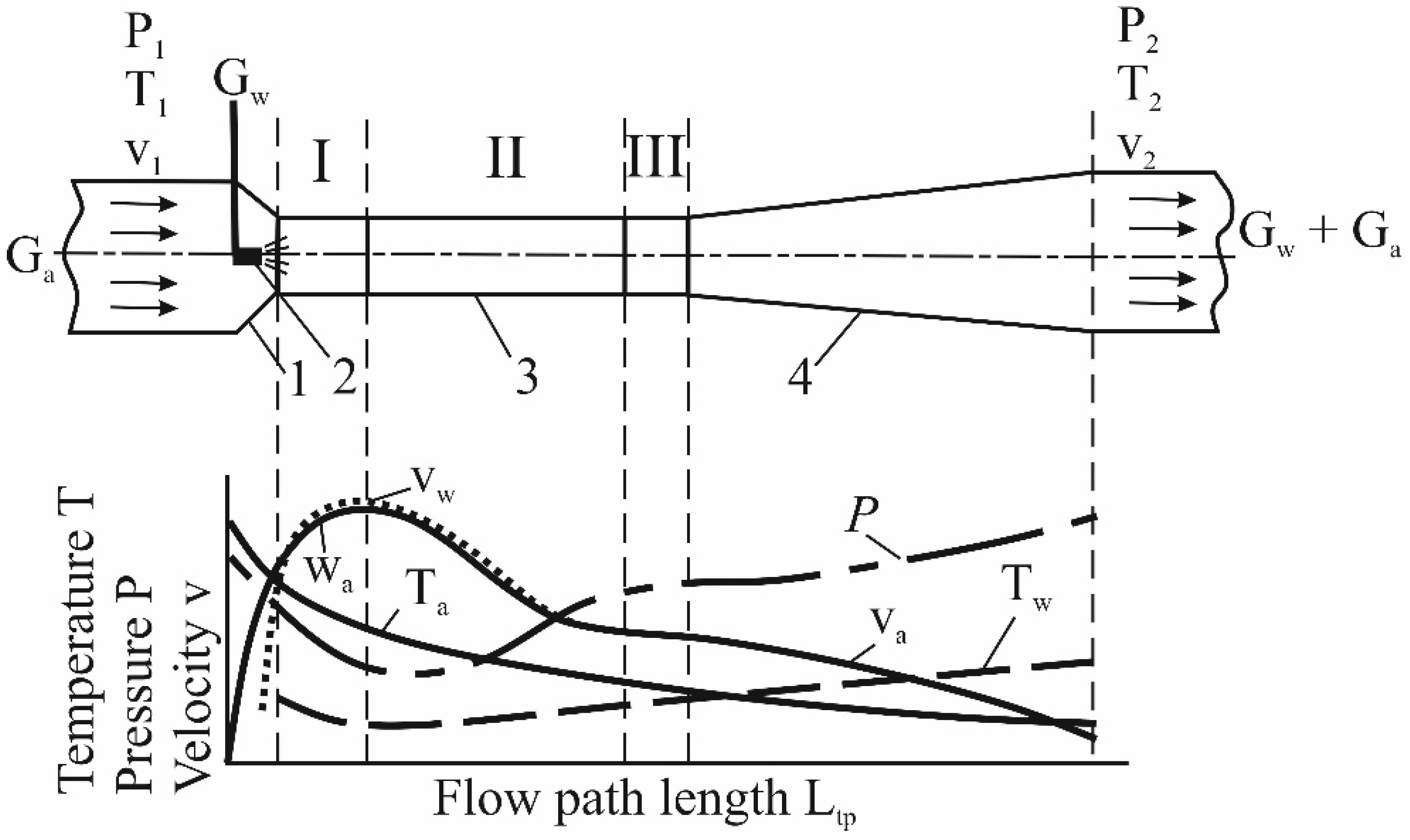
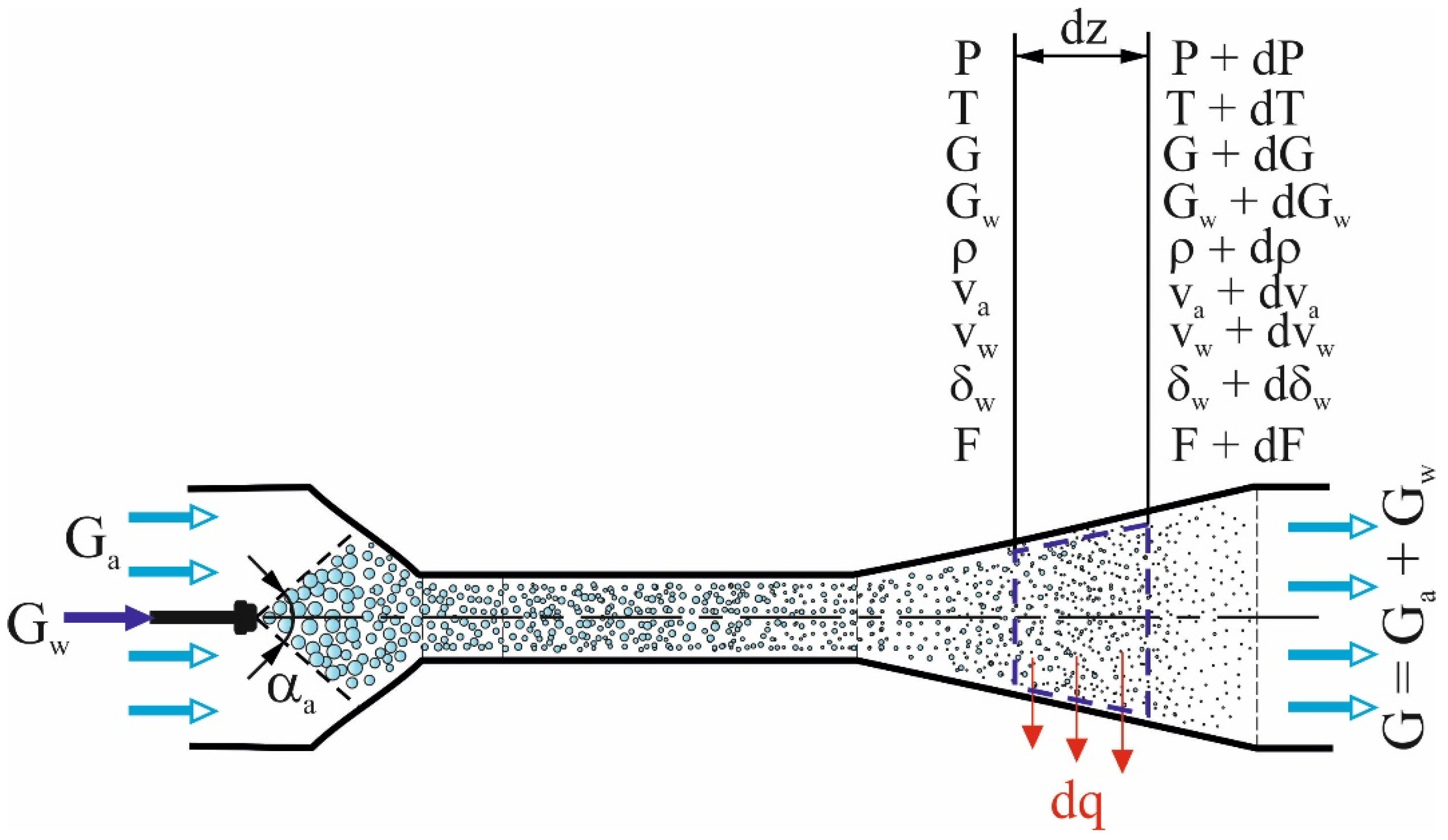

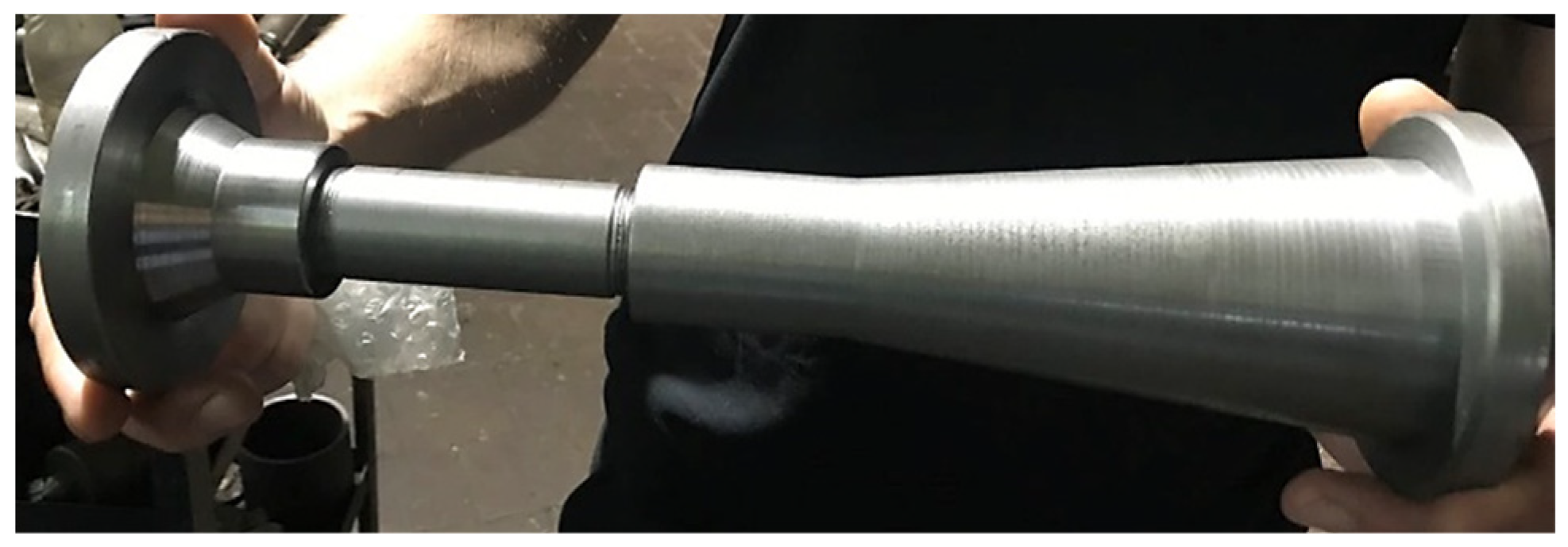
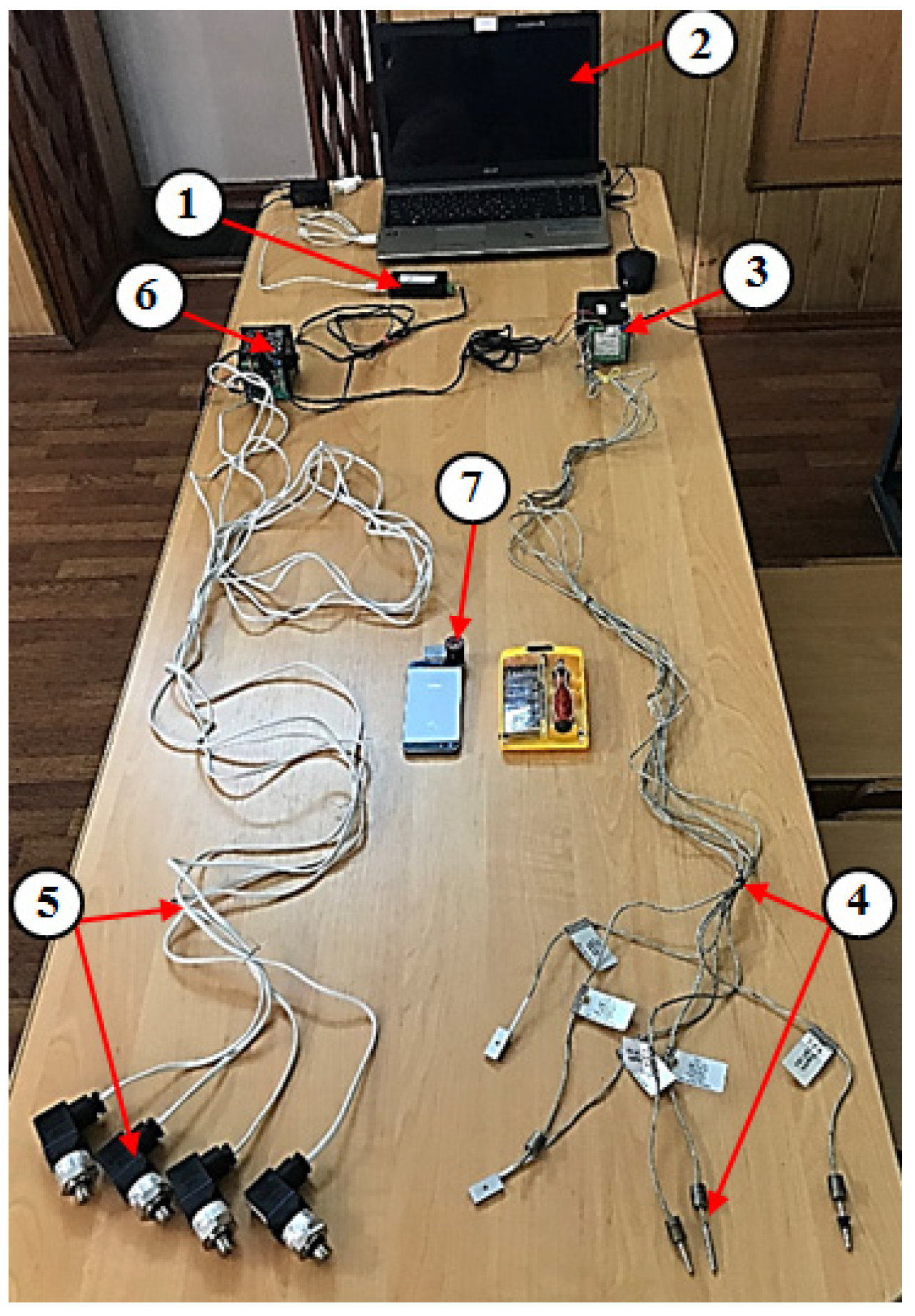
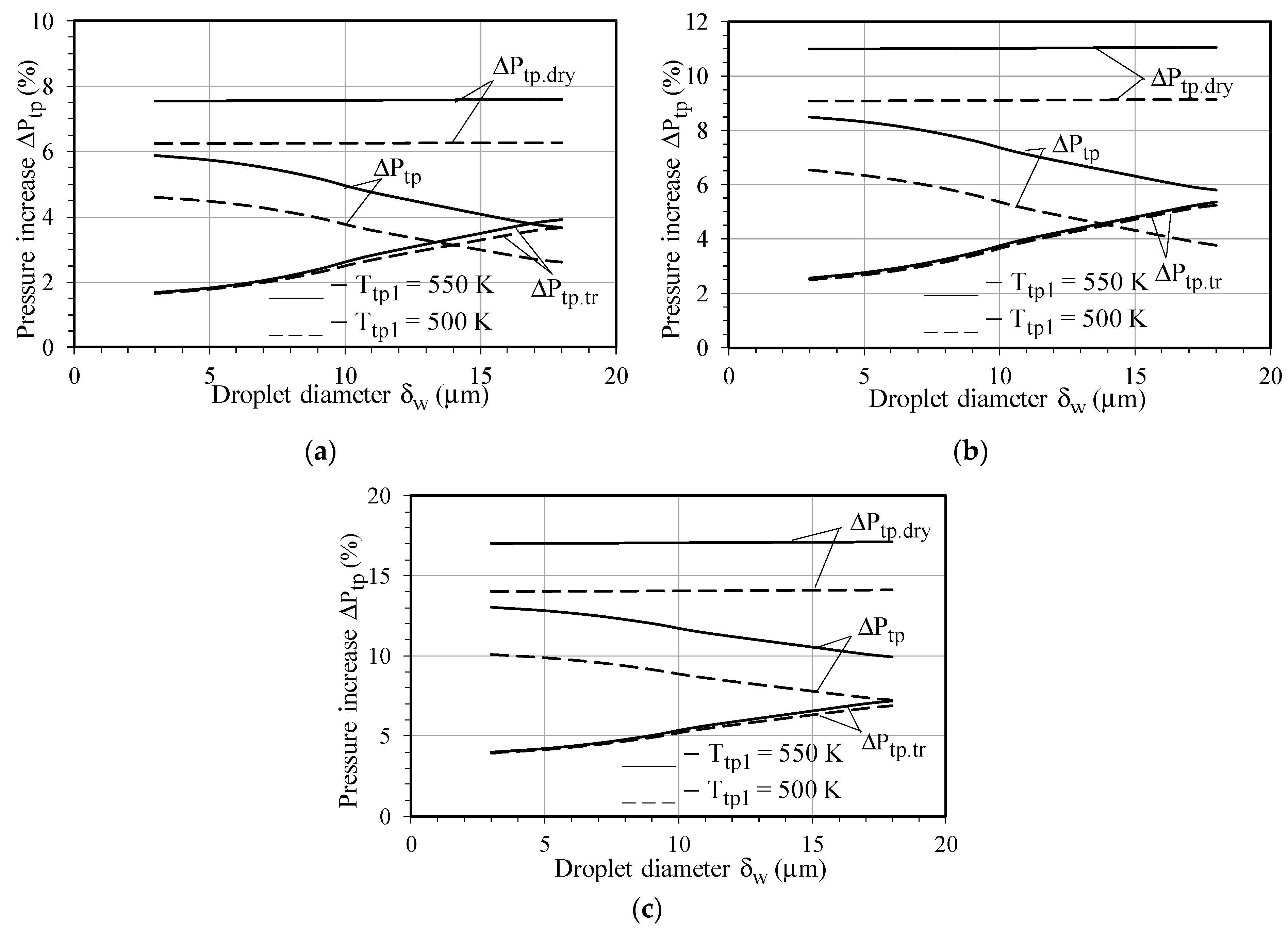
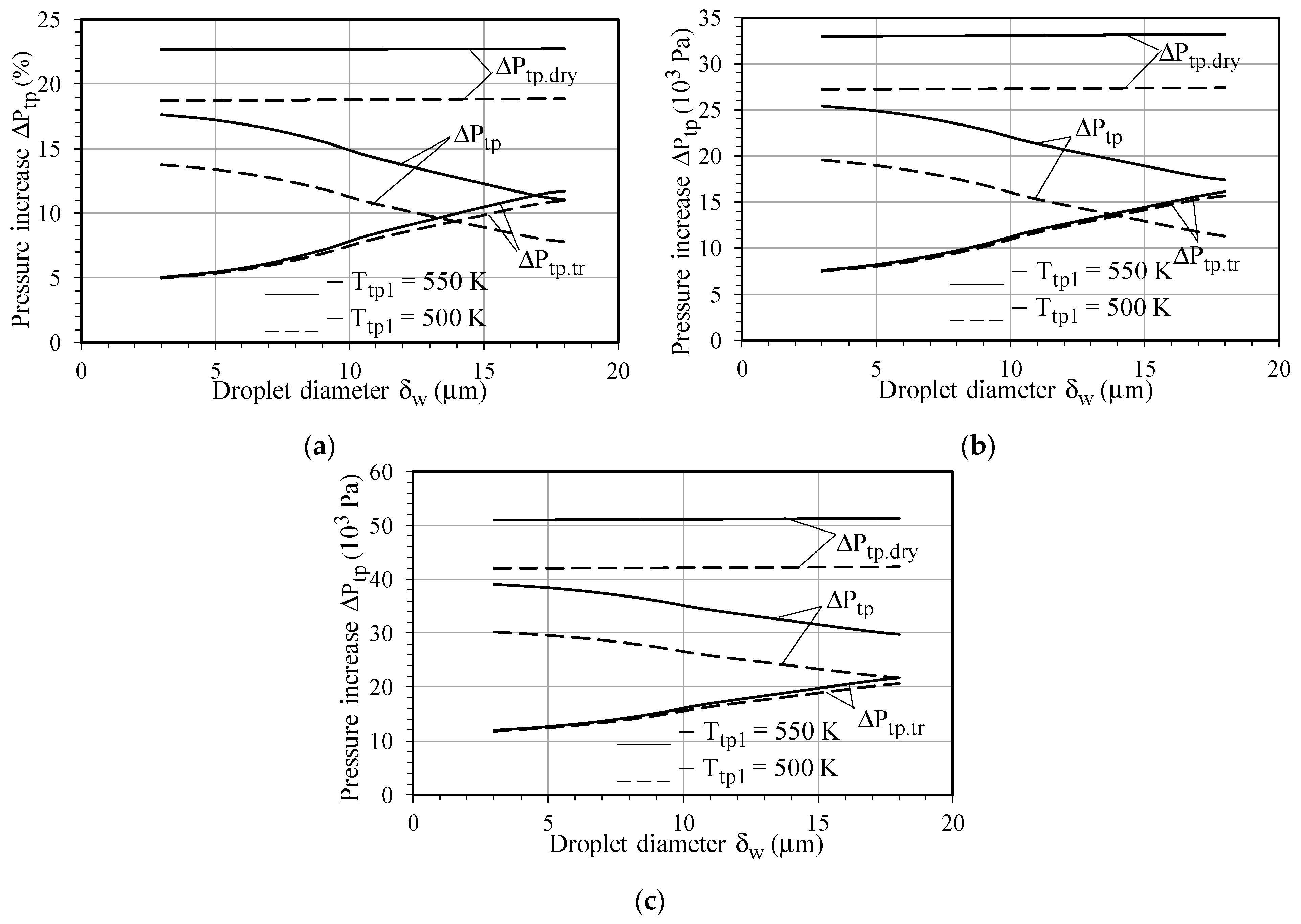
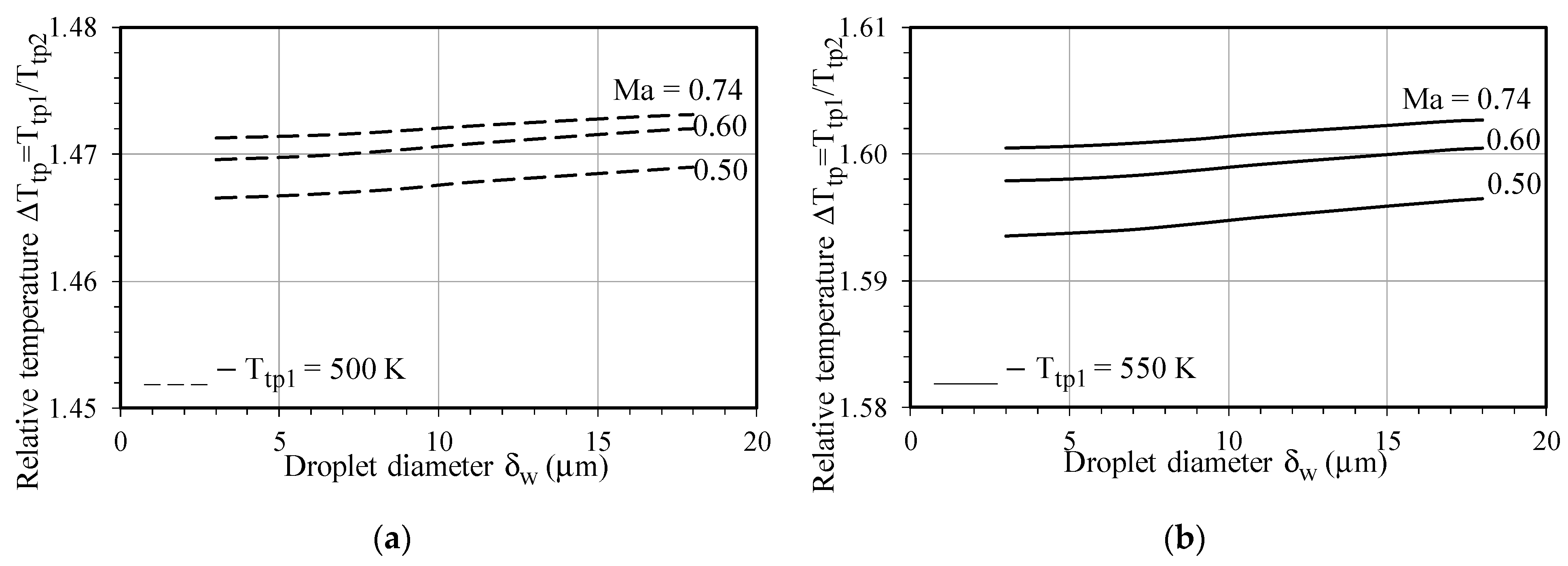
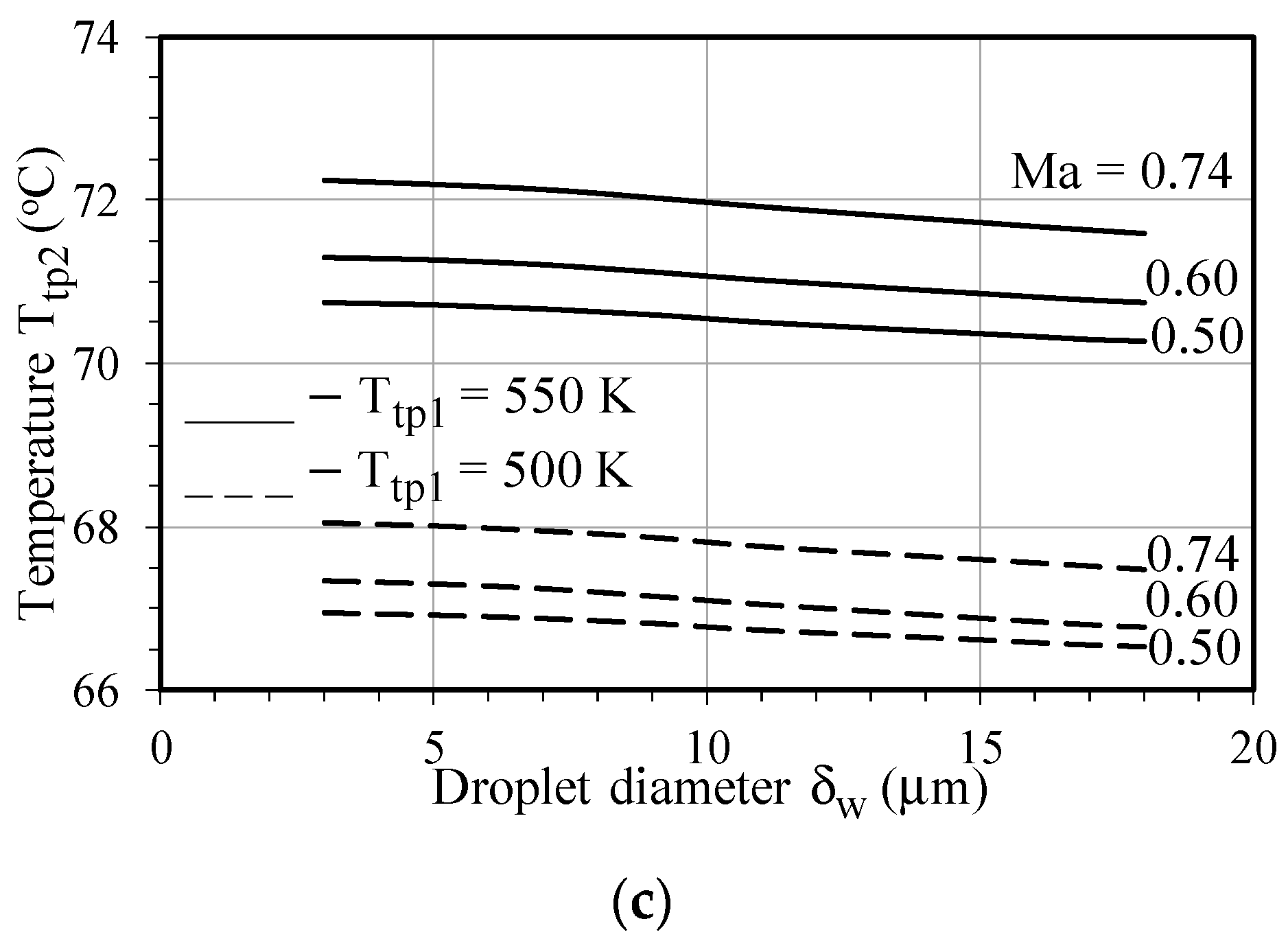
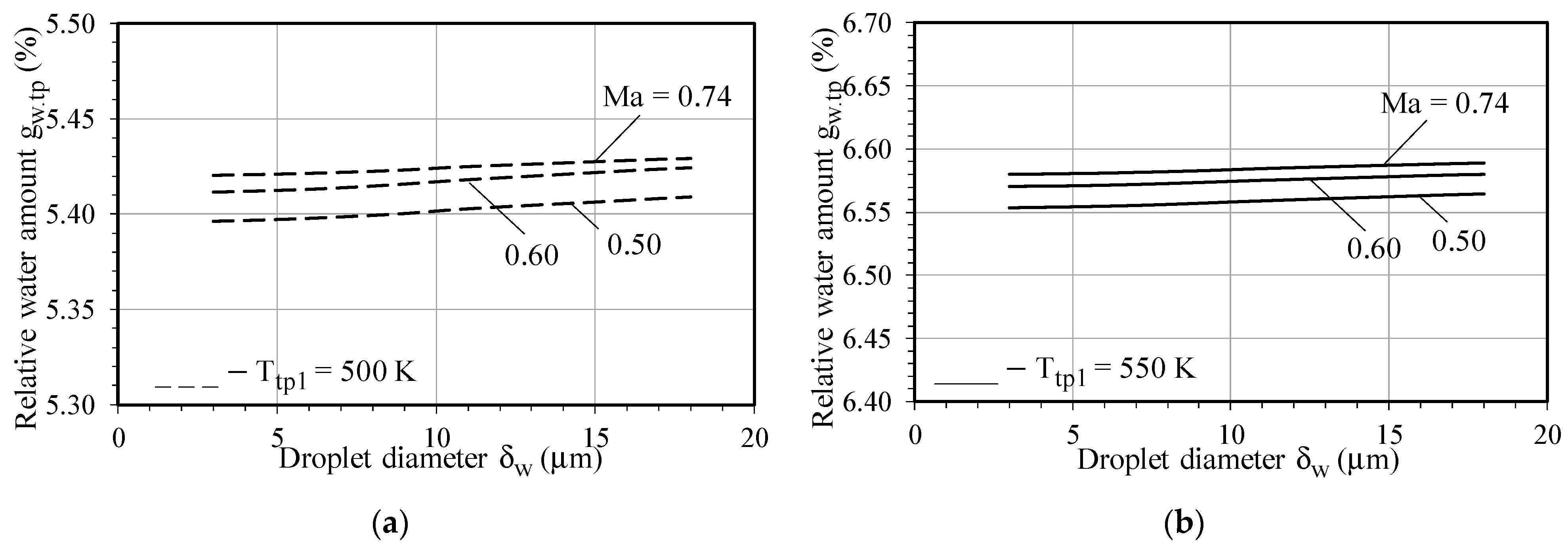
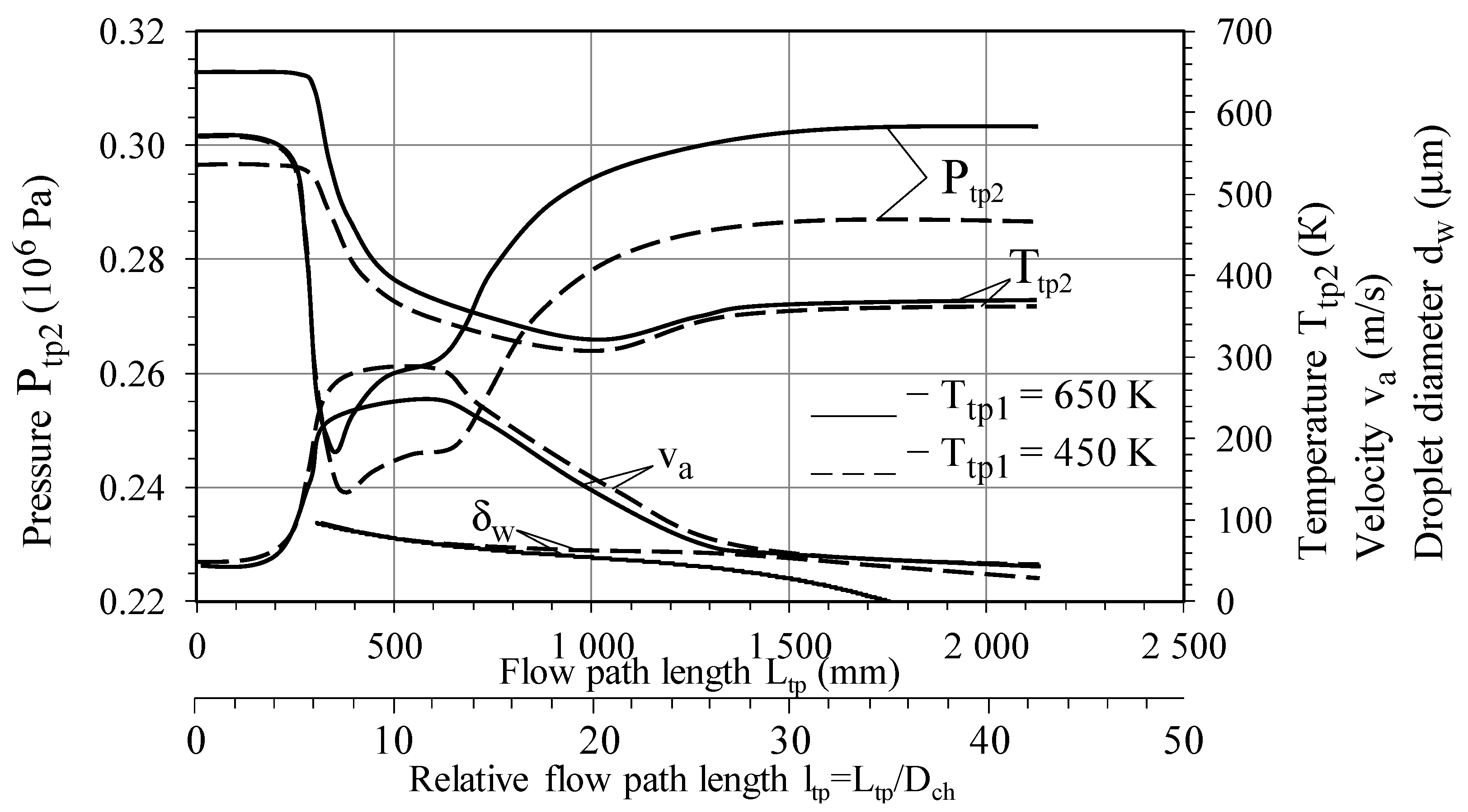

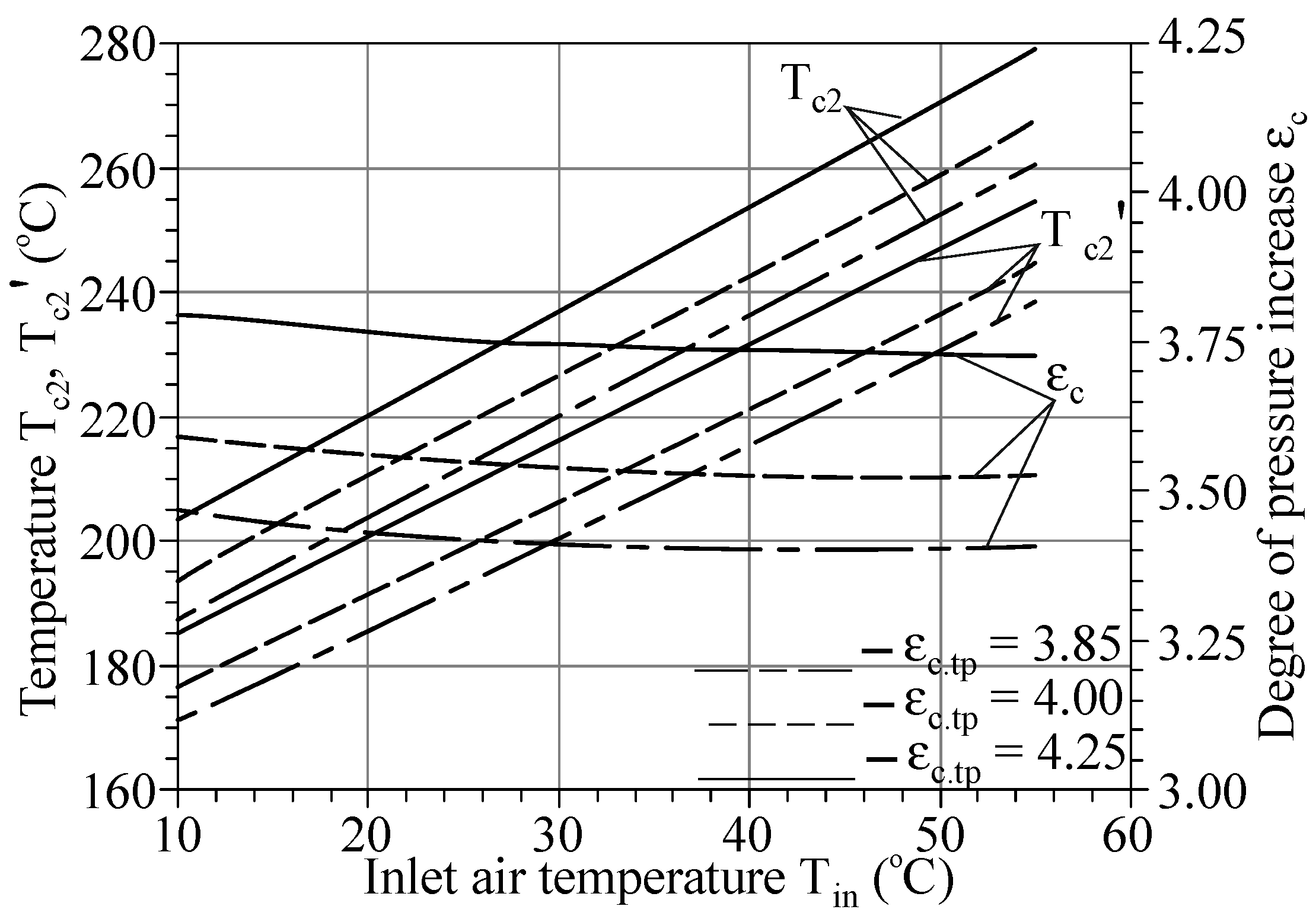

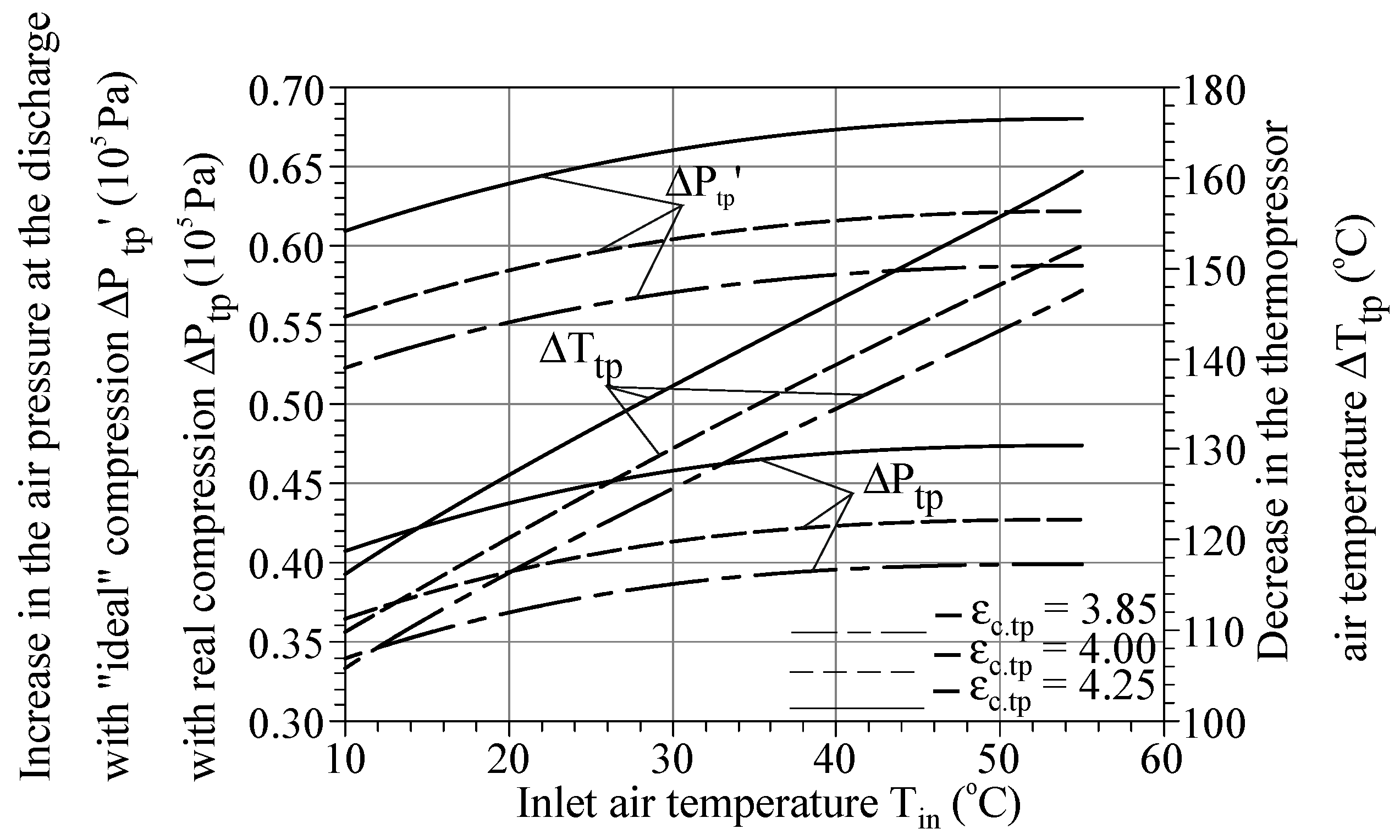
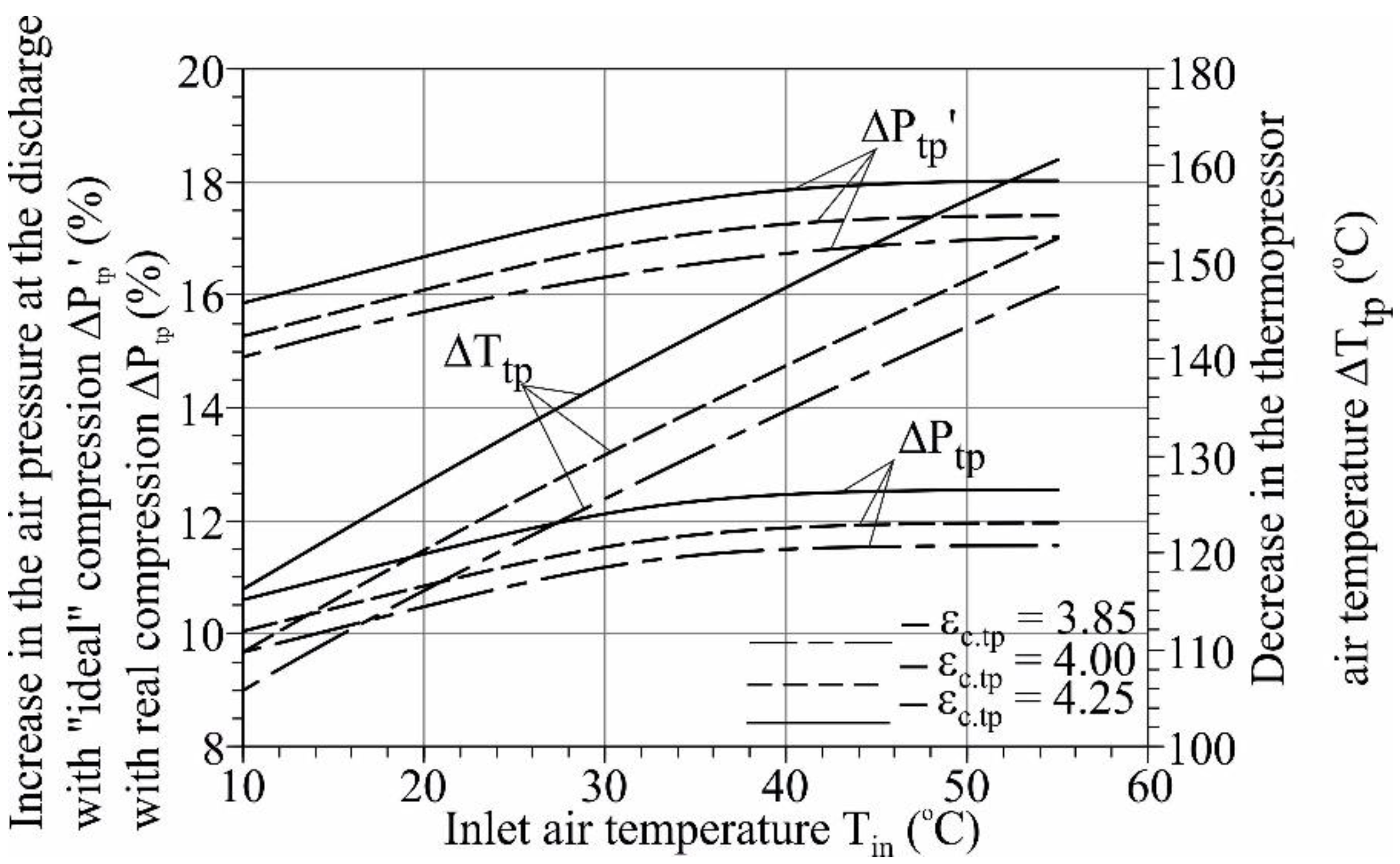
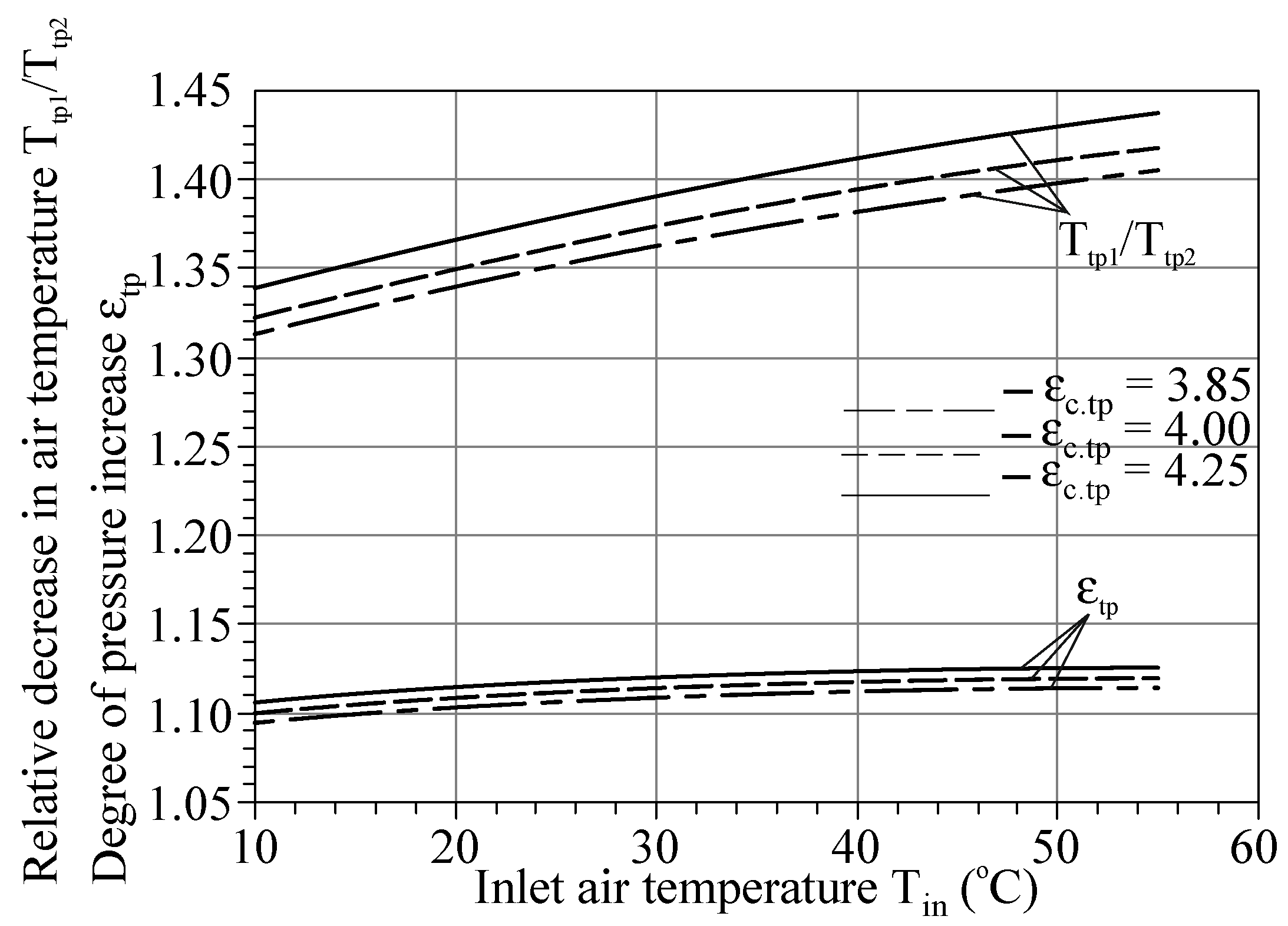

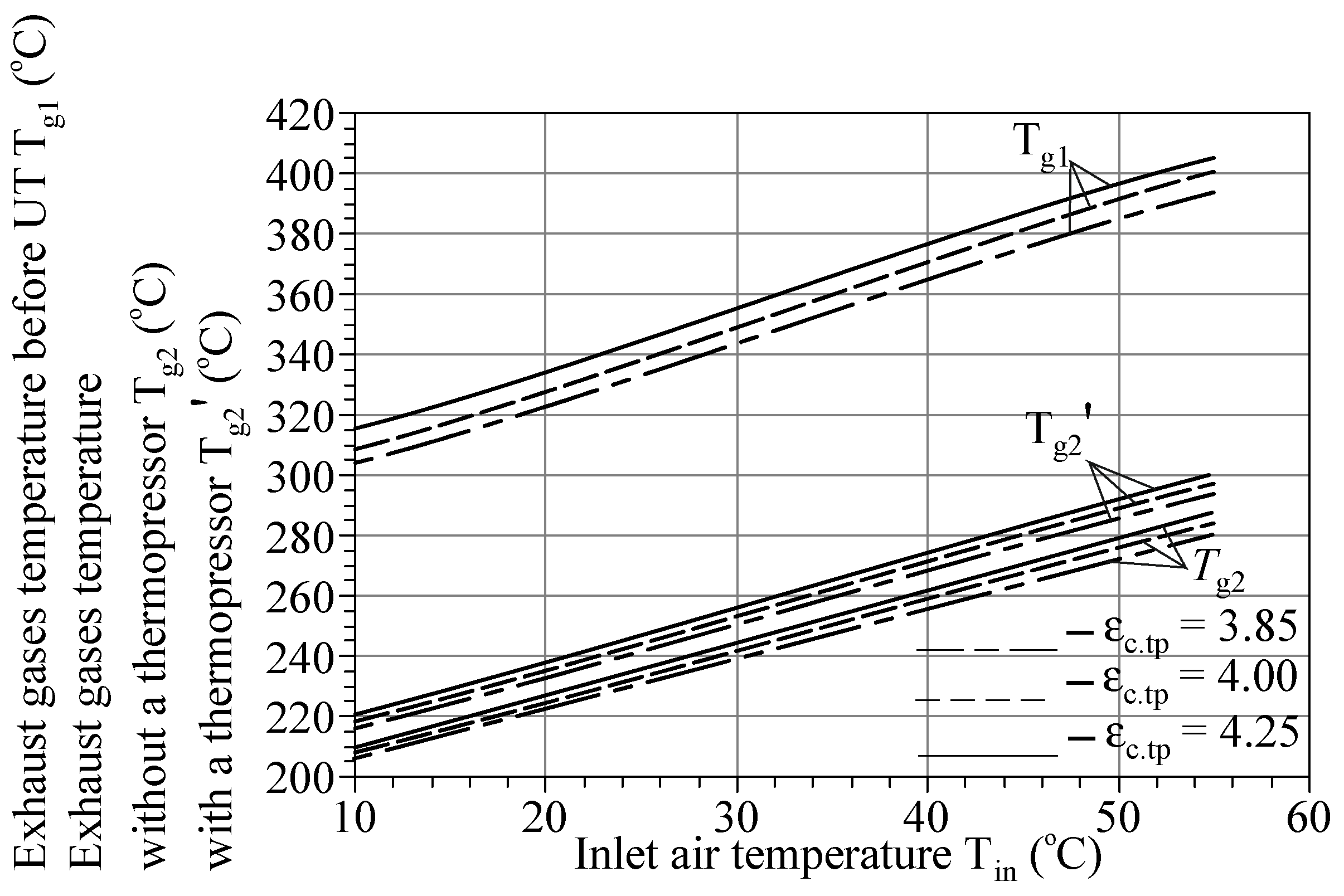
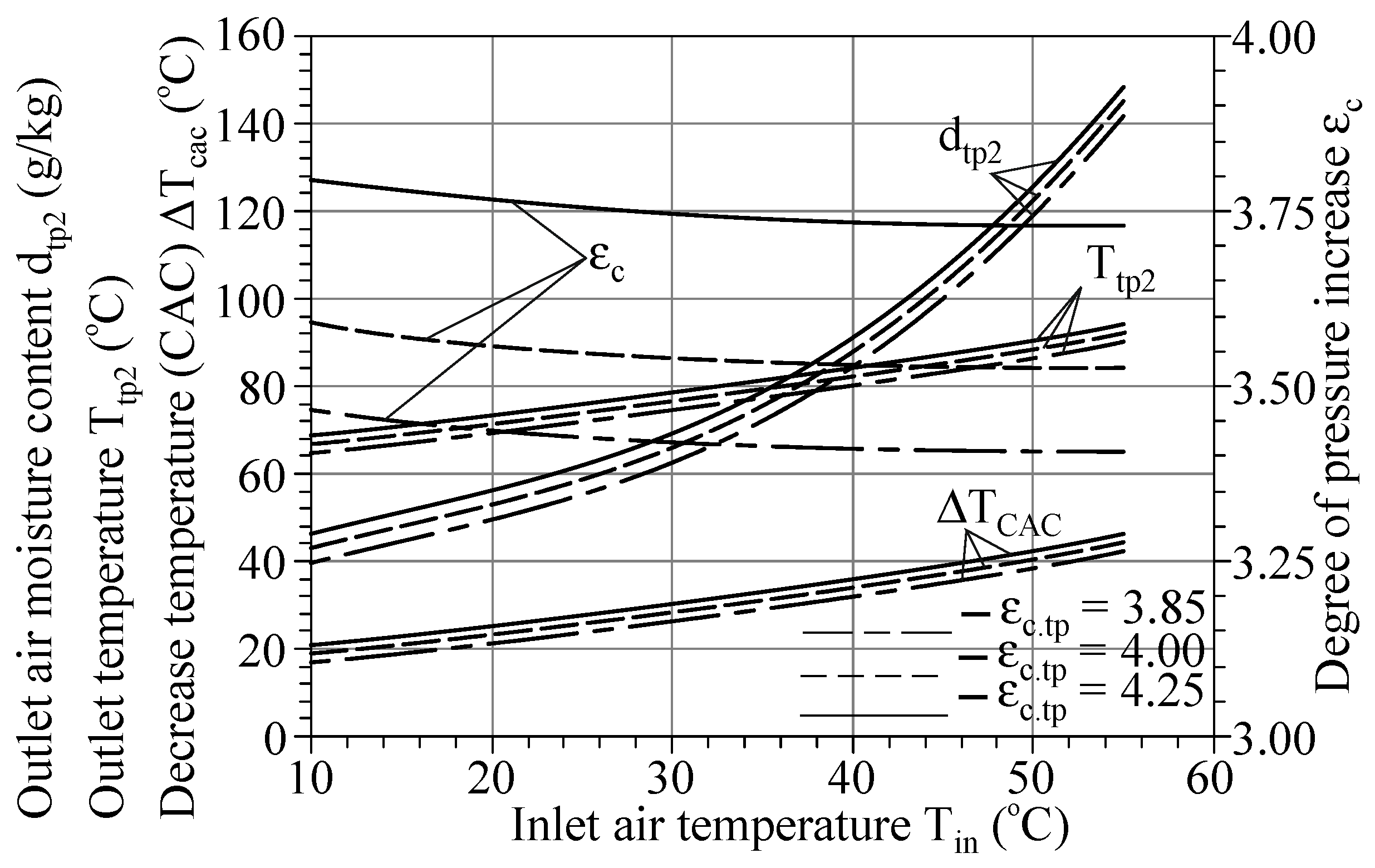

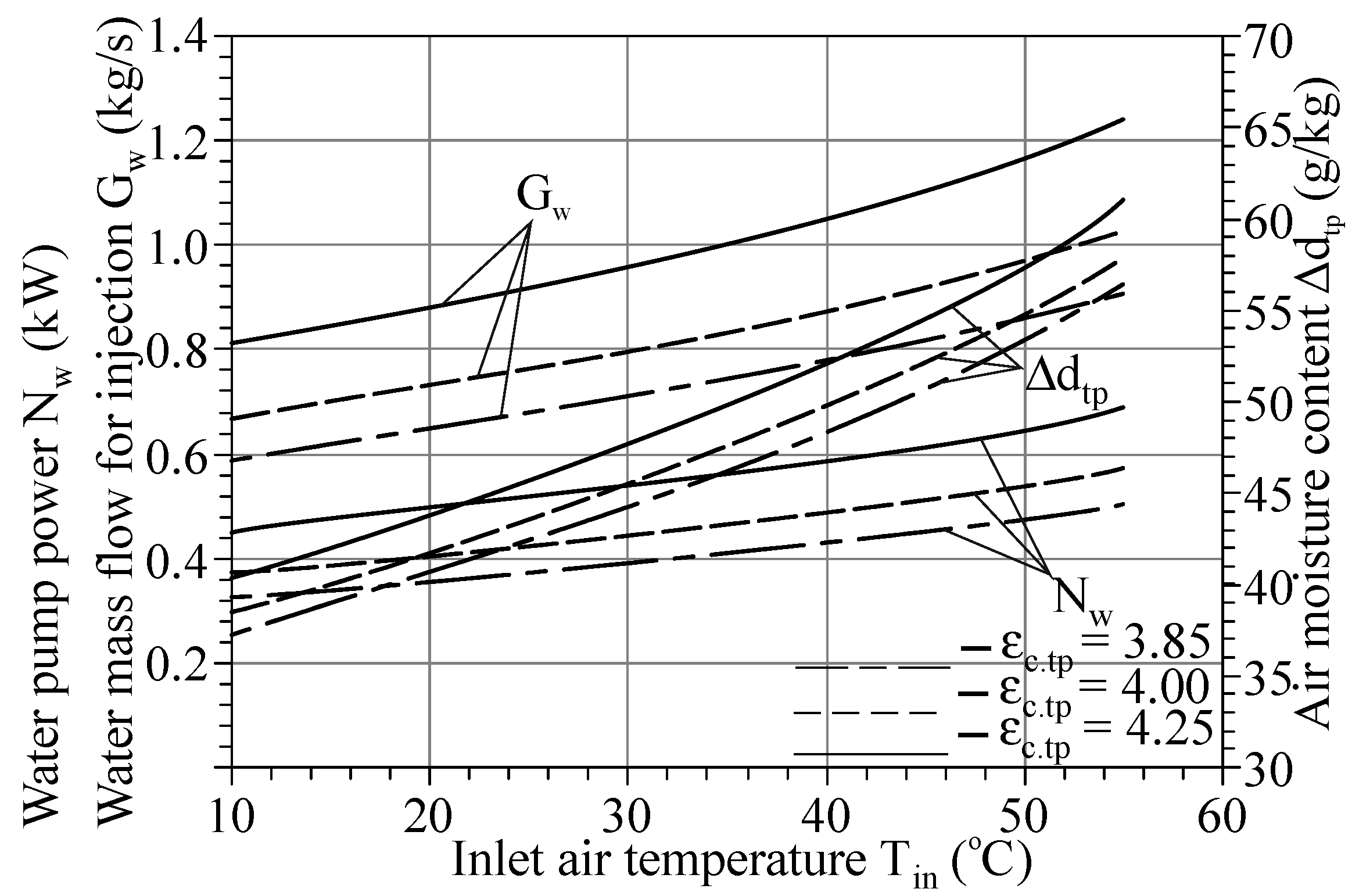
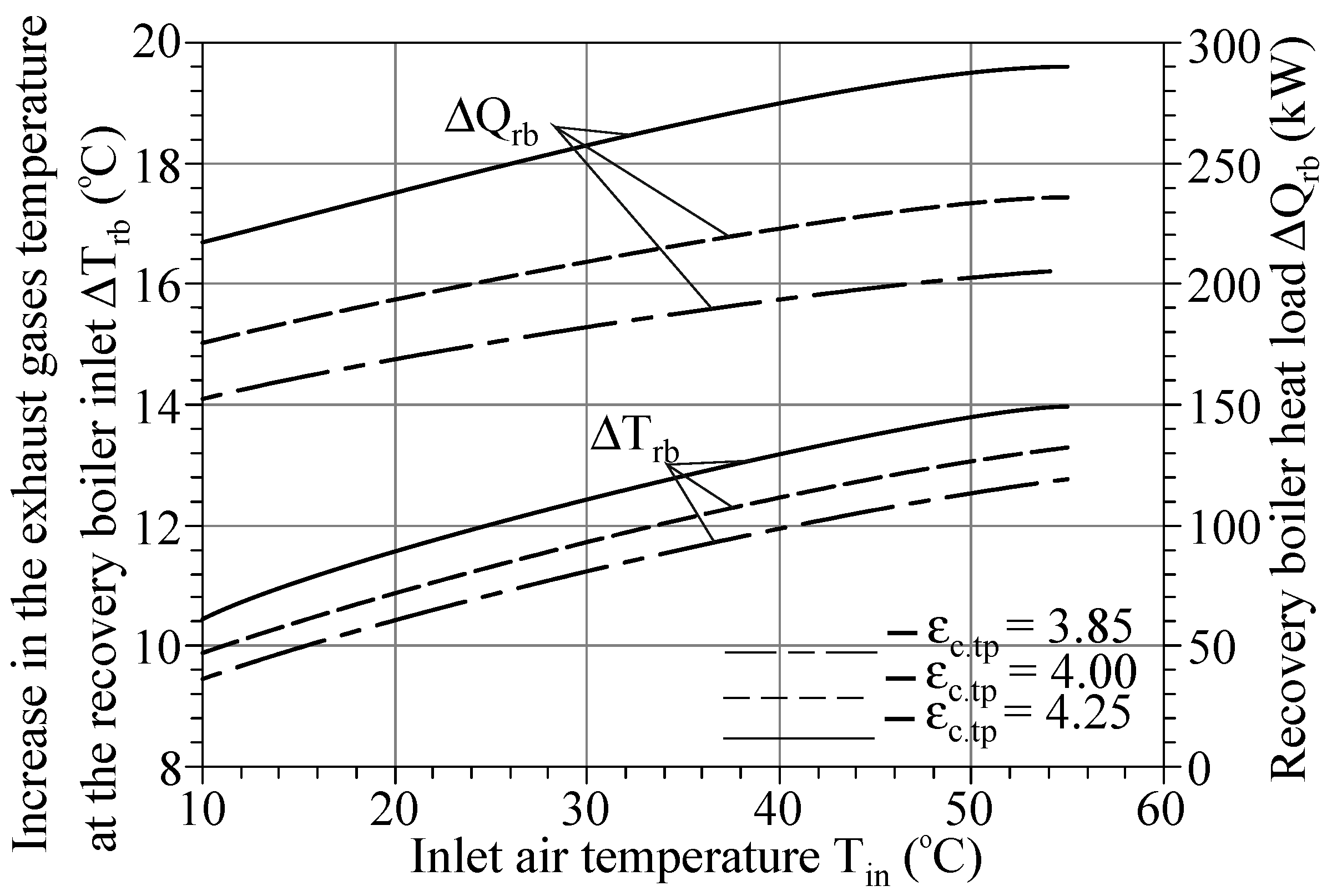
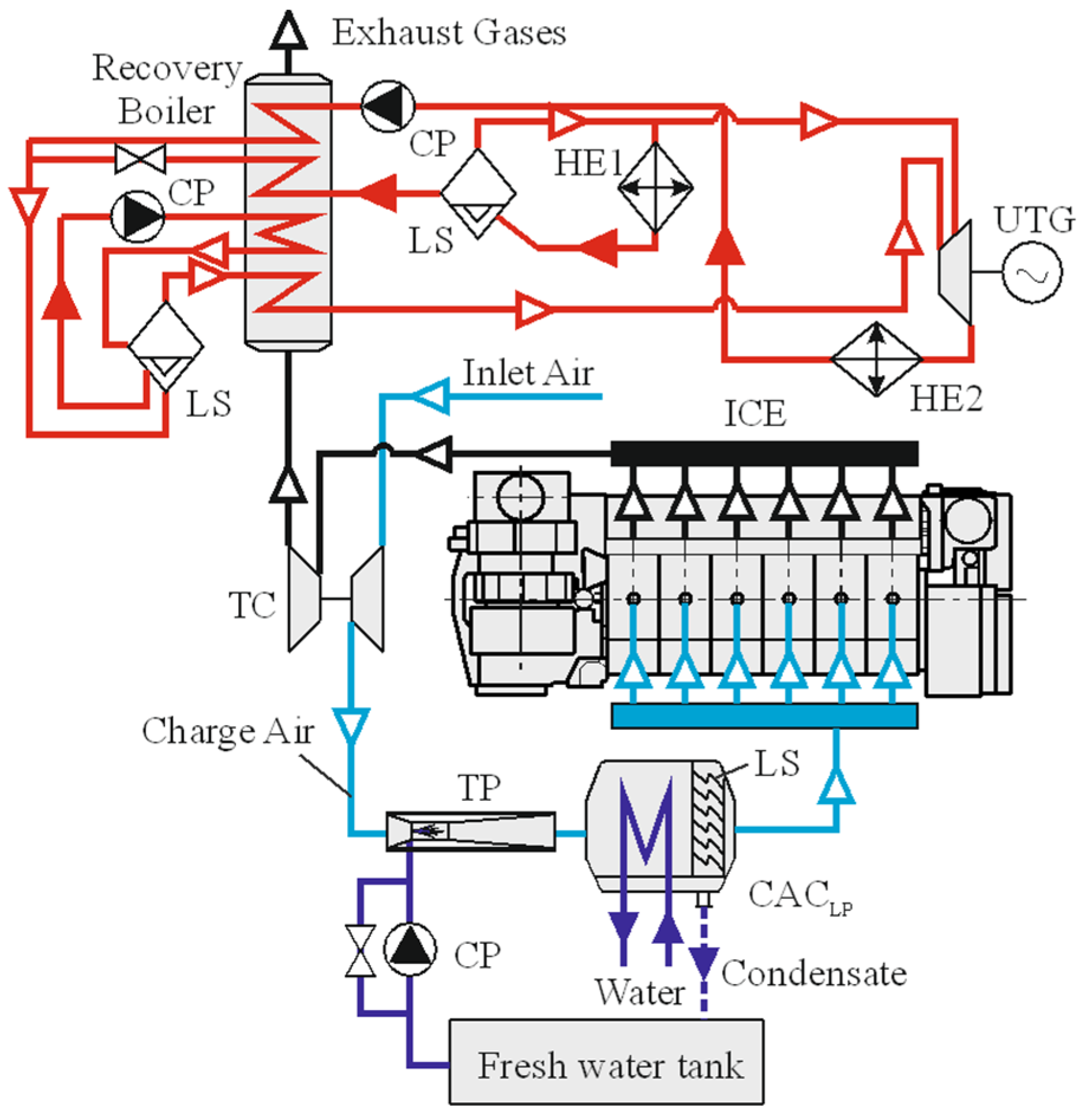
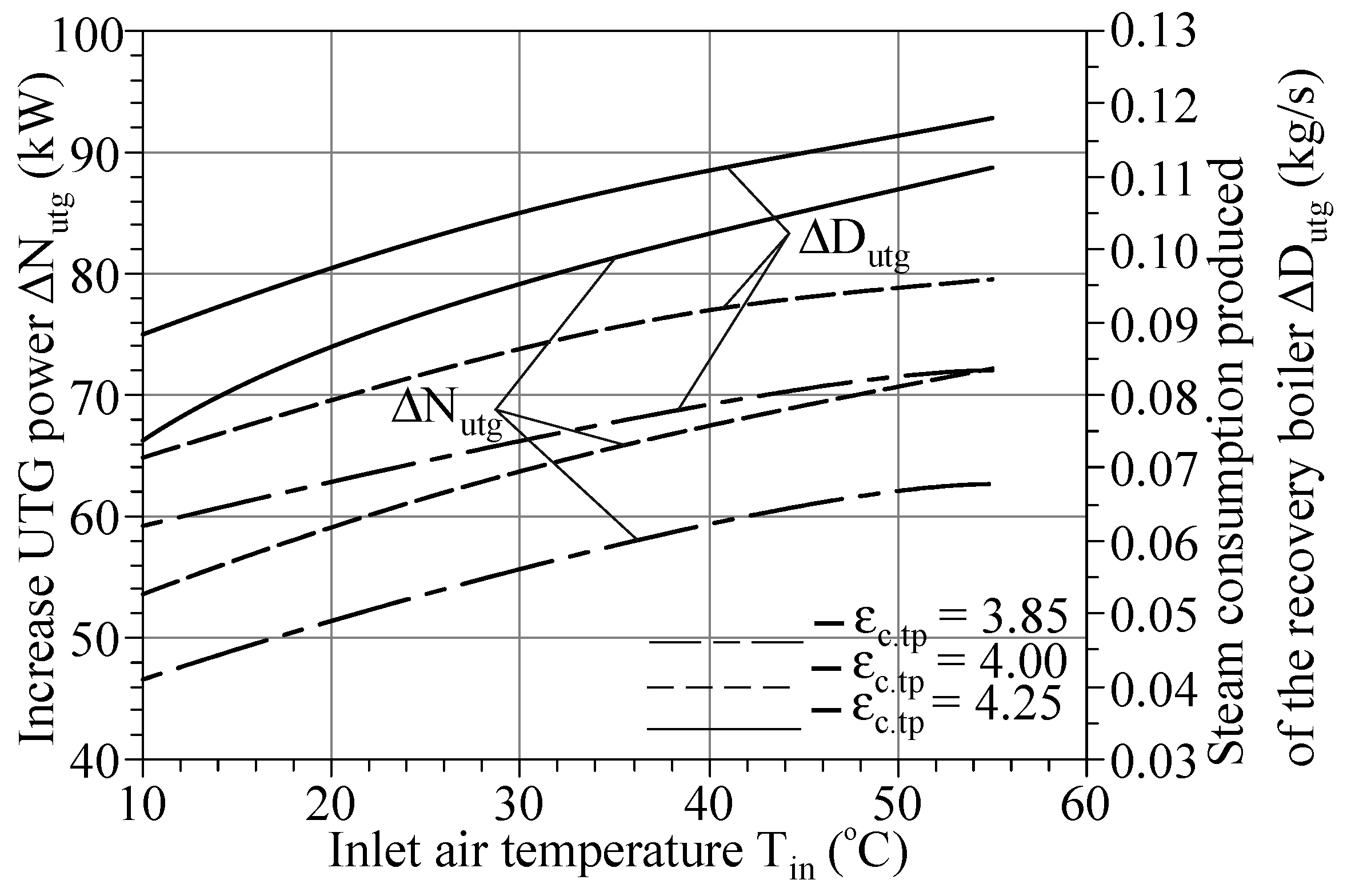
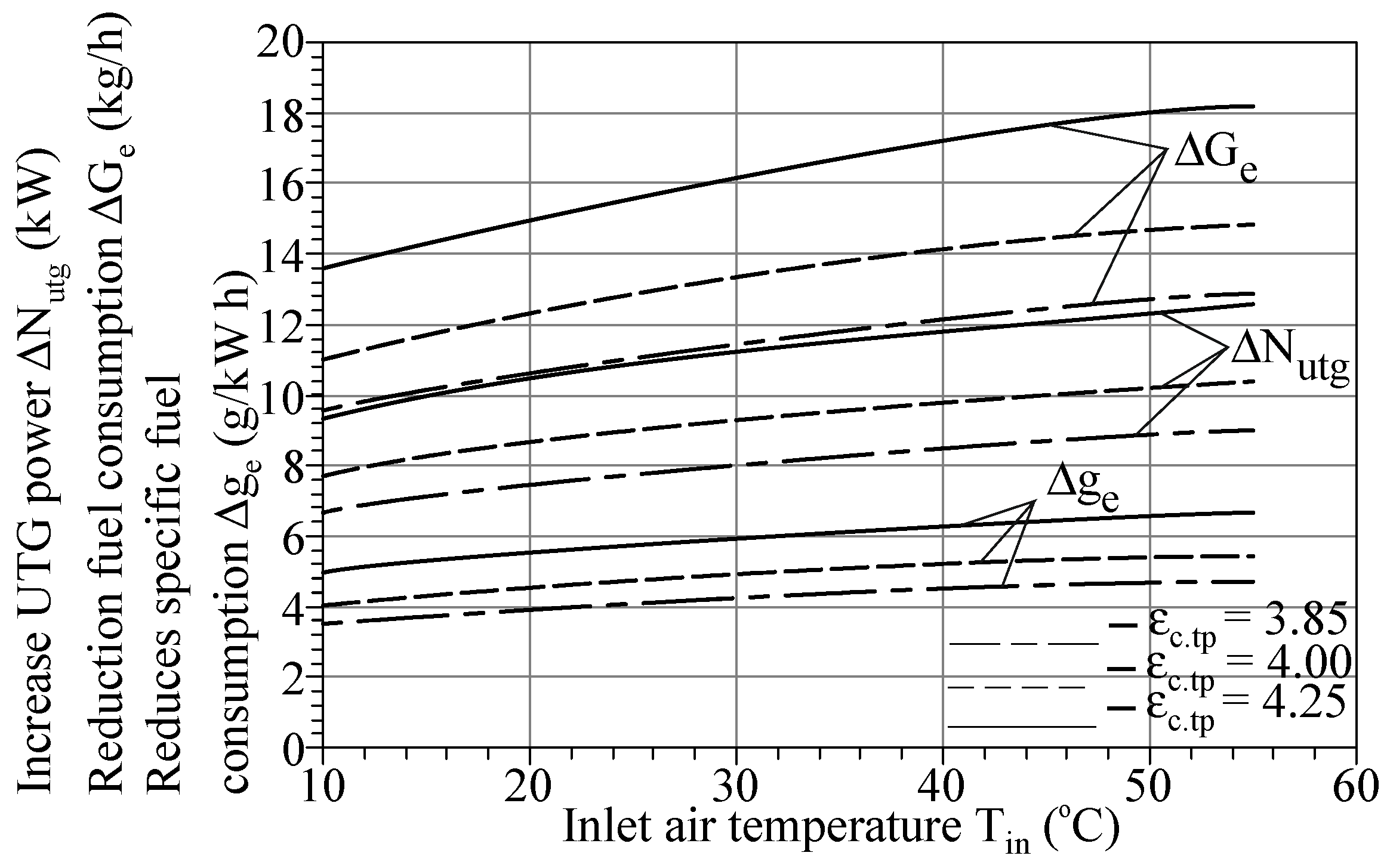
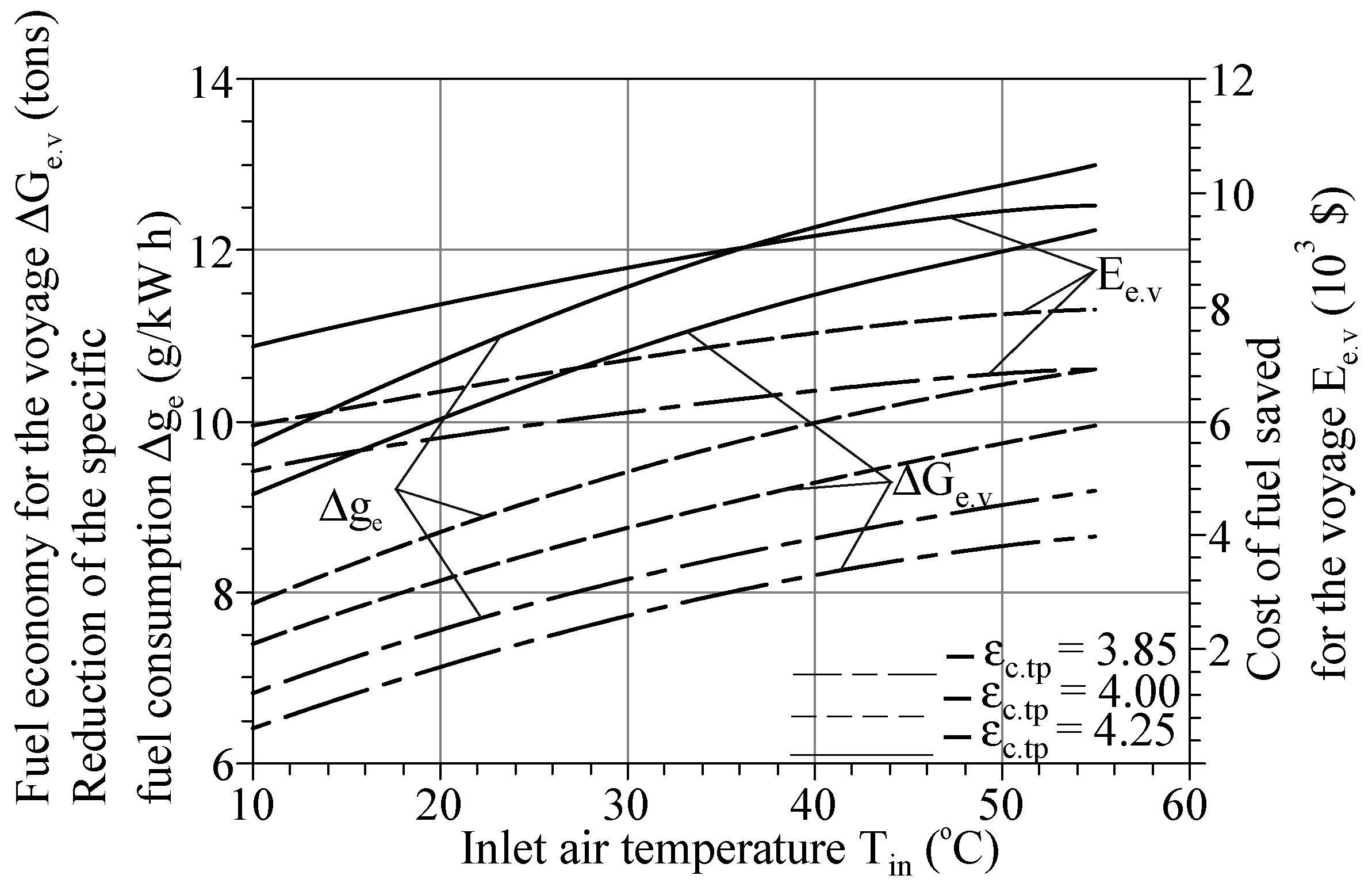
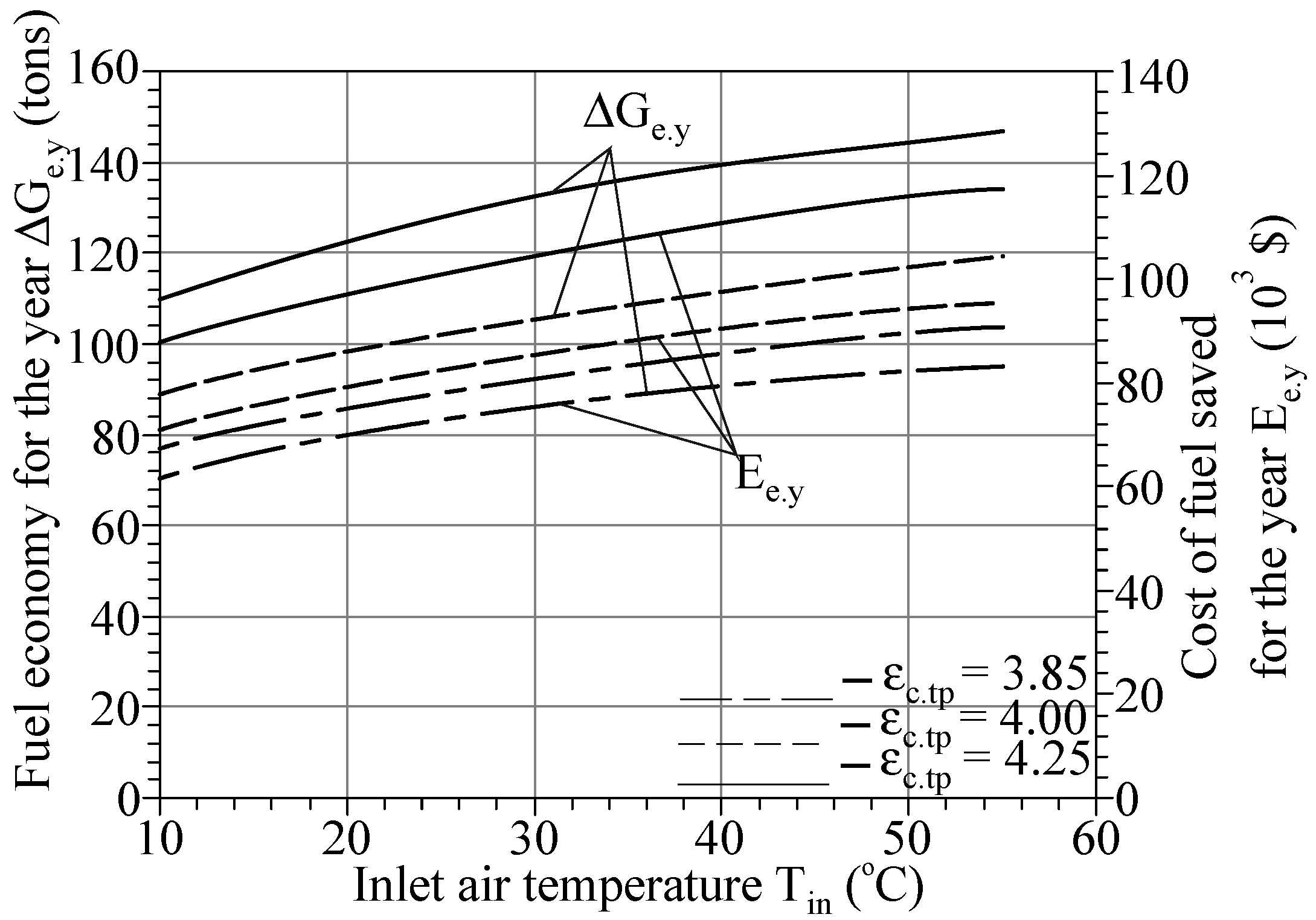
| Parameter | Value |
|---|---|
| Receiving chamber | Value |
| Confuser | Diameter D1 = 65 mm; length L1 = 200 mm |
| Evaporation chamber | Inlet diameter Dc1 = 65 mm; outlet diameter Dc2 = 25 mm; length Lc = 34 mm; convergent angle α = 30° |
| Diffuser | Diameter Dch = 25 mm; length Lch = 125; 175 mm (relative length lch = 5; 7) |
| Nozzle | Inlet diameter Dd1 = 25 mm; outlet diameter Dd2 = 65 mm; length Lch = 192 mm; divergent angle β = 6° |
Publisher’s Note: MDPI stays neutral with regard to jurisdictional claims in published maps and institutional affiliations. |
© 2022 by the authors. Licensee MDPI, Basel, Switzerland. This article is an open access article distributed under the terms and conditions of the Creative Commons Attribution (CC BY) license (https://creativecommons.org/licenses/by/4.0/).
Share and Cite
Yang, Z.; Konovalov, D.; Radchenko, M.; Radchenko, R.; Kobalava, H.; Radchenko, A.; Kornienko, V. Analysis of Efficiency of Thermopressor Application for Internal Combustion Engine. Energies 2022, 15, 2250. https://doi.org/10.3390/en15062250
Yang Z, Konovalov D, Radchenko M, Radchenko R, Kobalava H, Radchenko A, Kornienko V. Analysis of Efficiency of Thermopressor Application for Internal Combustion Engine. Energies. 2022; 15(6):2250. https://doi.org/10.3390/en15062250
Chicago/Turabian StyleYang, Zongming, Dmytro Konovalov, Mykola Radchenko, Roman Radchenko, Halina Kobalava, Andrii Radchenko, and Victoria Kornienko. 2022. "Analysis of Efficiency of Thermopressor Application for Internal Combustion Engine" Energies 15, no. 6: 2250. https://doi.org/10.3390/en15062250
APA StyleYang, Z., Konovalov, D., Radchenko, M., Radchenko, R., Kobalava, H., Radchenko, A., & Kornienko, V. (2022). Analysis of Efficiency of Thermopressor Application for Internal Combustion Engine. Energies, 15(6), 2250. https://doi.org/10.3390/en15062250










